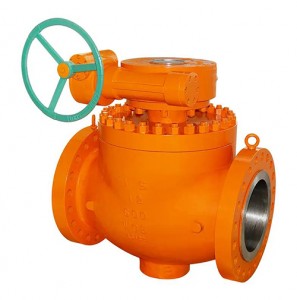
The classification of ball valves can be carried out from multiple dimensions, the following is a detailed introduction to the main classification of ball valves:
First, classification by structural form
1. Floating ball valve: The ball valve is floating, and the valve seat through contact to form a seal. When the medium passes through the ball valve, the medium pressure pushes the ball to the seat, so that the ball and the seat are tightly combined to achieve the sealing effect.
2. Fixed ball valve: The ball valve is fixed, and a certain gap is maintained between the valve seat. When the medium passes through the ball valve, the medium pressure does not change the position of the ball, but it changes the size of the flow path, thereby controlling the flow of the fluid.
Second, according to the opening and closing parts of the sphere assembly classification
Top type ball valve, side mounted ball valve, split ball valve. The side-mounted type can be divided into integral, two-stage, three-stage and five-stage. This classification is mainly concerned with the assembly and layout of the internal structure of the ball valve.
Third, according to the sealing material classification
1. Soft sealing ball valve: The sealing material is soft material such as rubber or polytetrafluoroethylene, which is suitable for fluid pipelines with high sealing requirements.
2. Hard sealed ball valve: The sealing material is metal material, which is suitable for the fluid pipeline used in the harsh environment such as high temperature and high pressure.
Fourth, classified by channel type
Full diameter ball valve, neck ball valve, double neck ball valve, etc. This classification mainly focuses on the diameter and shape of the ball valve channel to meet the needs of different flows and pressures.
Fifth, according to the valve function and use conditions classification
Switch two-way ball valve (such as O-type ball valve), three-way, four-way reversing shunt ball valve (such as L-type tee, T-type tee, Y-type tee), V-type regulating ball valve, insulated jacket ball valve, eccentric half ball valve, three-eccentric metal seal ball valve and other functional ball valves. These ball valves are designed according to the specific needs of use, with different functions and characteristics.
Sixth, according to the form of connection classification
1. Flange connection ball valve: suitable for all kinds of fluid pipelines, through the flange connection.
2. Threaded ball valve: Suitable for small diameter and low pressure fluid pipelines, through the thread connection.
3. Welding ball valve: including socket welding and butt welding two ways, suitable for the need for high strength connection in the fluid pipeline.
4. Clamp ball valve: Suitable for small caliber fluid pipelines, the ball valve is fixed on the pipeline through two clamp bodies.
5. Clamp connection ball valve, sleeve connection ball valve and other connection mode ball valve, also has its own application occasions and characteristics.
Seventh, according to the driver classification
1. Manual ball valve: The valve is opened and closed by manual operation, which is suitable for various fluid pipelines.
2. Electric ball valve: The valve is opened and closed by electric drive, which is suitable for automatic control system and remote control.
3. Pneumatic ball valve: The valve is opened and closed by compressed air, which is suitable for fluid control systems requiring fast response and high precision. In addition, there are hydraulic ball valves, gas-liquid linkage ball valves, electric hydraulic ball valves and other driving mode ball valves.
Eighth, according to the use of temperature classification
Low temperature ball valve, normal temperature ball valve, high temperature ball valve, etc. This classification method mainly focuses on the temperature range of the ball valve to ensure the normal operation of the ball valve at different temperatures.
Ninth, according to material classification
Ball valve materials are also very diverse, including carbon steel, alloy steel, stainless steel, cast iron, titanium alloy, monel, copper alloy, aluminum alloy, lead alloy and other metal materials valves; Rubber lined, fluorine lined, lead lined, plastic lined, enamel lined and other metal body lined valves; And ceramic, glass, plastic and other non-metallic materials valves. These ball valves of different materials have their own applicable media and working conditions.
In summary, the classification of ball valves is diverse, from the structural form, sealing material, channel type, valve function and use conditions, connection form, drive mode, use temperature to material and other dimensions of classification. In practical applications, it is necessary to select the right type of ball valve according to the specific use needs and working conditions.
Post time: Jul-30-2024






